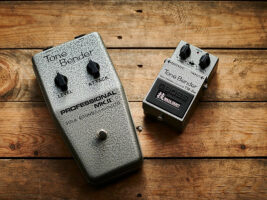
Cause & Effects: Are vintage effects pedals always the best examples of their type?
Look across guitar social media, magazines, forums and websites, and you’ll that there is a real love for vintage effects right now. A post of a vintage fuzz face, a vintage piece of rack gear or old transistors etc receives so much frenzied clicking it’s amazing to witness. What’s impressive though is how this reverence seems to transcend all demographics.
READ MORE: Bossk’s Alex Hamilton on the joys of riffs, Matamps and tuning to double-drop F#
Everyone, it seems, sees these battered old boxes as the absolute pinnacle of the effects pedal hierarchy, and yet as a pedal geek and engineer I find myself torn between the obvious nostalgia of them and the reality that things really have progressed in the effects world.
Why Is There All This Love For Vintage Pedals?
To begin to answer this you need to look at other leisure industries. The guitar world is not unique in its love for classical artefacts, indeed the most valuable cars of all time are pretty much all from the 1950s and 1960s (the priciest being the $142,000,000 Mercedes Benz 300SLR Uhlenhaut coupe), the only exception being the 1992 McLaren F1.
Part of their popularity and veneration comes from their scarcity – very few were made to start off with, and no more are being made, as such supply and demand economics comes into effect. Secondly these vehicles had a profound effect on the car market when they entered it and over the years, accidents, mechanical failure etc has reduced the number of units available too.
The very same thing can be said about effect pedals. Effects such as the Fuzz Face, Rangemaster and Tonebender changed the face of music forever. Many guitarists from the post-WWII generation were in their formative years when this happened and as such the sound of music from that period is etched into their psyches. To recreate the music of their youth these effects are vital and what better way to recreate the music than use the authentic vintage article. The crazy thing about this is that demand for the vintage effects is generated by all generations of guitarists, including people who collect vintage effects, this further drives up demand for a fixed supply of pedals.
It’s not just pedals from the 60s either. In every decade up to now there is an effect type or brand that has been used to create iconic music and the only way to get that sound is to use that effect, for example think of the MXR Phase 90 and EVH immediately comes to mind.
So its economics 101, a very limited (and diminishing supply) of vintage pedals against a hoard of buyers, some of which have increasingly high disposable income and a desire to emulate their guitar heroes.
But what about the sound?
If you pick up any of these vintage units you will get variability in the sound quality that they produce, but if you are lucky to get a “good one”, the sound will indeed be glorious.
The key thing about the sound though is that all the vintage sounds can be recreated with either modern recreations of pedals using modern parts or modern “forensic perfect” recreations using vintage parts for extra mojo. I don’t use the word mojo negatively at all, there is something to be said about the link between how something makes you feel versus how something performs. Just because something performs perfectly doesn’t mean you’ll “gel” with it in the same way as a lesser performing pedal that you enjoy owning because of its provenance. This explains the desire for the vintage item.
What about drawbacks?
The provenance and vintage authenticity are what allows people to overcome a lot of the difficulties vintage pedals provide, such as being: hard to source, high in cost, huge physical size, more difficult power arrangements, battery only, impedance issues, noisy circuitry due to age degradation and poor physical condition due to old age. It’s quite a list, but as pedal geeks we turn a blind eye to all of it in order to chase the vintage authenticity.
The one thing I would never sacrifice though is sound. It must sound good or what’s the point? The most likely cause for a vintage pedal sounding poor is a degradation in the passive components such as electrolytic capacitors drying out or resistors drifting away from their specified values.
So are these vintage pedals the pinnacle
The short answer is no they are not. Vintage pedals are a fascinating look at effects history. If you must own one, please do so with total understanding of the difficulties outlined above and you’ll enjoy the experience. If a pedal’s sound, performance and price are your priority then I’d recommend you look elsewhere and seek a modern recreation of the vintage item or branch out and try something new entirely.
For more features, click here.
The post Cause & Effects: Are vintage effects pedals always the best examples of their type? appeared first on Guitar.com | All Things Guitar.
Source: www.guitar-bass.net












